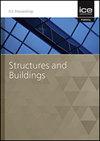钢筋混凝土梁的抗扭强度极限
IF 1.4
4区 工程技术
Q3 CONSTRUCTION & BUILDING TECHNOLOGY
Proceedings of the Institution of Civil Engineers-Structures and Buildings
Pub Date : 2023-01-20
DOI:10.1680/jstbu.22.00099
引用次数: 0
摘要
为了促进箍筋在混凝土破碎前的屈服,避免钢筋混凝土构件的超配筋破坏模式,现行设计规范规定了最大抗剪配筋量和抗扭配筋量的限制。研究表明,基于平面桁架法引入的抗剪极限能较好地估计最大抗剪强度和抗剪破坏模式。然而,基于空间桁架类比和薄壁管理论推导的抗扭极限,普遍高估了最大抗扭强度。通过分析406根受剪构件和153根受扭构件的试验结果,评价了引入现行设计规范的最大抗剪强度和抗扭强度限值之间的差异。另外,对22根受扭转作用的RC梁进行了试验试验,直接测量腹板混凝土的应变率,研究扭转强度限值。结果表明,基于空间桁架模型推导的抗扭极限值高估了实际最大抗扭强度。基于这些观察结果,提出了一个较低的最大扭转强度限值,以避免过度加固扭转破坏本文章由计算机程序翻译,如有差异,请以英文原文为准。
Torsional strength limitation of reinforced concrete beams
In order to promote yielding of stirrups prior to concrete crushing and avoid the over-reinforced failure modes in reinforced concrete (RC) members, the current design codes stipulate limits on the maximum amount of shear and torsional reinforcement. Studies show that the shear strength limits introduced based on the plane-truss approach estimate the maximum shear strength and shear failure mode with reasonable accuracy. However, the torsional strength limits which are derived based on the space truss analogy and thin-walled tube theory, generally overestimate the maximum torsional strength. In this study, the difference between the limiting values introducing the current design codes on the maximum shear and torsional strengths was evaluated by analyzing the test results of 406 shear and 153 torsional members. Additionally, experimental tests were conducted on 22 RC beams subjected to torsional moments to directly measure the strain rate of the web concrete and investigate the torsional strength limit values. The results indicate that f the torsional strength limit values derived based on the space truss model overestimate the actual maximum torsional strength. Based on these observations, a lower limiting value for the maximum torsional strength is proposed to avoid over-reinforced torsional failure
求助全文
通过发布文献求助,成功后即可免费获取论文全文。
去求助
来源期刊
CiteScore
3.40
自引率
6.20%
发文量
61
审稿时长
12 months
期刊介绍:
Structures and Buildings publishes peer-reviewed papers on the design and construction of civil engineering structures and the applied research associated with such activities. Topics include the design, strength, durability and behaviour of structural components and systems.
Topics covered: energy conservation, people movement within and around buildings, strength and durability of steel and concrete structural components, and the behaviour of building and bridge components and systems

 求助内容:
求助内容: 应助结果提醒方式:
应助结果提醒方式:


